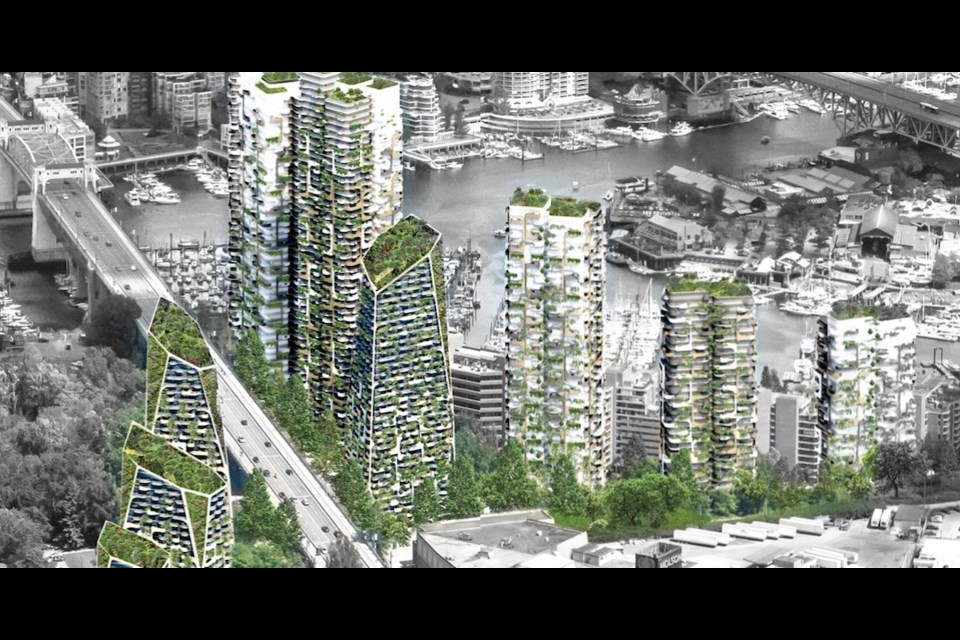Vancouver city hall’s landmark agreement to enable construction and provide utilities to the Squamish Nation’s 11-tower condo development around the Burrard Bridge is 250 pages long.
An appendix lists $48.43 million of costs estimated for 15 street, bike lane, sewer and seawall projects, mostly paid by the Nation. Of that, $15 million is the estimate for the Squamish Nation to build a transit hub on the Burrard Bridge.
But a government information watchdog said it was published in back-of-the-napkin fashion.
Vancouver city hall’s communications department sent two advisories before and one after Mayor Kennedy Stewart signed the agreement May 25 with Squamish Nation council chair Dustin Rivers, aka Khelsilem.
The city’s freedom of information office (FOI) told a reporter in early July to file another request in mid-August. Then the communications department quietly published the agreement the day after the summer’s last city council meeting, on July 29, the Friday of the B.C. Day long weekend.
“It's important that when a government at any level starts working in these types of things, that they are appropriately transparent, and they're not making it up as they go along,” said Jason Woywada, the executive director of the B.C. Freedom of Information and Privacy Association.
“When a public institution can't undertake routine business in a routine way, that's where questions start coming up, that’s where trust starts being eroded. Even more tricky when you start getting into elements of reconciliation, appropriate negotiations and the nation-to-nation relationship.”
Squamish Nation members agreed to a 50-50 partnership in 2019 with Westbank Development, which is planning to build up to 6,000 rental units in four phases on Kitsilano Indian Reserve land known as Senakw.
An Ernst and Young report commissioned for the project and provided to Squamish Nation members in 2019 estimated Senakw could generate as much as $12.7 billion in cashflow.
By 2029, up to 10,000 people could be living on the 10.6 acres regained through court settlements.
The heart of the deal is the 40-page contract that spells out how Senakw will connect to the city’s water and storm sewers, sidewalks, roads, bike lanes and public transit. Because it is on reserve land, under the auspices of federal departments, the city’s normal permitting, taxation and user fee collection powers do not apply. The Nation agreed to pay in full for service delivery and lifecycle costs and reimburse the city for costs it incurs.
City hall agreed to notify the Squamish Nation on area work that could impact the construction site, “but that does not fetter in any way city council and the city engineer’s legal rights and duties to manage city streets in the public interest.” Likewise, the Squamish Nation must regularly update the city with its design and construction schedule.
When the contract and appendices were released, the title page stated it was the “final execution version for May 25, 2022 effective date.”
Angela MacKenzie, city hall’s associate director of civic engagement and communications, said the Squamish Nation took the lead on communications and the city hall FOI office was likely not aware of the exact timing of the release.
“When the Nation released the full agreement on their website on July 29, they asked to take the lead on sharing this with media and the public,” MacKenzie said. “The city supported this by creating a corresponding webpage, which was also made public on July 29.”
Senakw is officially a partnership between Westbank and the Squamish Nation’s Nch’kay Corporation.
Westbank is famous for building luxury downtown towers, like the Shaw Tower, Fairmont Pacific Rim, Shangri-La and Telus Garden, and marketing condos for sale in Hong Kong and Singapore. Its latest construction project is the redevelopment of Oakridge Centre for 2,600 units in 10 buildings.



